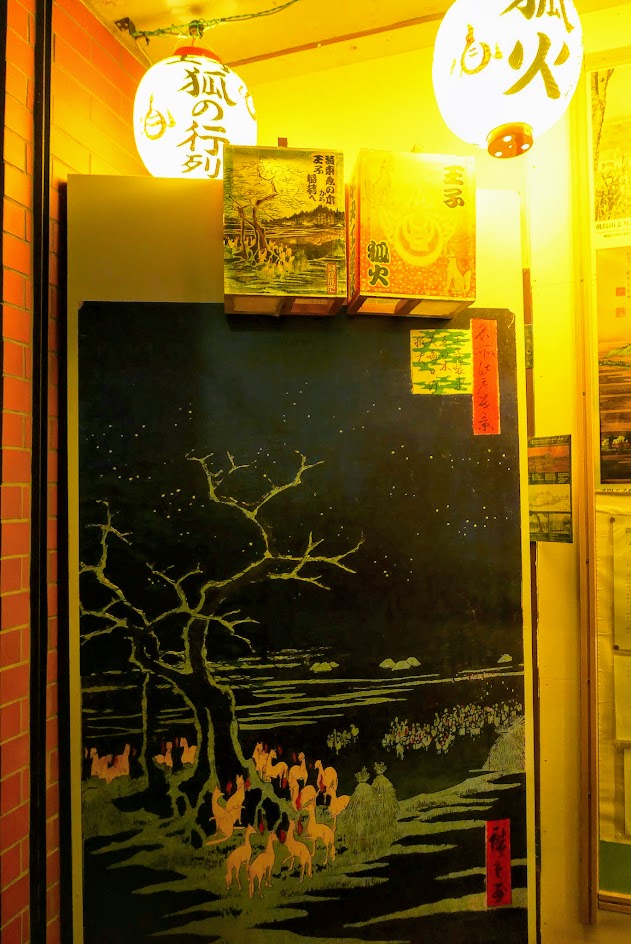Last year in December 2015, we spent Christmas and New Year’s in Japan. I’ve already covered previously some of the amazing Winter Illuminations that you can see during the winter season and that they have the lights not just for the December timed holidays. I also recommended that the winter season is a great time to visit the snow monkeys in the hot springs, and since winter is more clear a perfect time to stay at an onsen with a view of Mt Fuji. If you are there specifically during New Year’s time, I want to now add the recommendation of checking out a unique New Year’s Eve in Japan event of the Oji Fox Parade.
Unlike in the United States and many other countries, New Year’s Eve in Japan is not celebrated with big parties and fireworks and midnight kisses. You can find some parties at establishments that cater more to foreigners – for instance we stopped by a beer bar seemed to have a lot of expats and English speakers. Goodbeer Faucets, located only a few blocks away from Shibuya station in Tokyo, usually is already a fun visit with their 40 taps of beer. For New Year’s Eve, they were hosting a Drink It All Party where as their taps started to kick (aka become empty of that beer) the cost of all beer overall that evening would decrease. Pretty fun idea for a bar party.


New Year’s time in Japan is one of the most important holidays of the year. It’s seen as a time to prepare a fresh clean start, and time to be with family. On New Year’s Day itself, millions visit the shrines to pray for luck and a good new year. For some that may include lining up on New Year’s Eve not to party, but to just stand in line to await visiting the shrine as soon as it turns midnight.
In Tokyo, there is an area called Oji (serviced by a conveniently named Oji Station). According to a local folk tale, foxes gather in this Oji area from all over Japan on New Year’s Eve, disguised in human costume, to visit a shrine located here called Oji Inari-jinja Shrine. There is a famous piece of art by Utagawa Hiroshige during the 1797–1858 Edo period depicting this event. It shows the foxes (kitsune) gathering at a tree on New Year’s Eve to pay homage to Inari, Shinto god of the rice field, for whom the fox serves as messenger. On the way, the foxes have set a number of kitsunebi (foxfires), which farmers count to predict the upcoming rice harvest. You may see versions of the art around the area like we did.


New Year’s Eve Foxfires at the Changing Tree, Ōji by artist Utagawa Hiroshige
Every year on New Year’s Eve, a Oji Kitsune-no-gyorestu Fox Parade is held that goes from Shozoku Inari-Jinja Shrine and Oji Inari-Jinja Shrine.


Doll version of the Oji Kitsune-no-gyorestu Fox Parade displayed by Oji Station
Many of the locals are wearing fox masks or have faces painted like foxes – you can join in by purchasing a fox mask yourself if you’d like. The shrine-goers hold chochin lanterns representing the light of life and the light of hope, full of wishes of for the health and happiness of children.




Even before the parade starts, there is an area with a bonfire, snacks and especially sake as foxes in Japan are considered messengers of fertility, agriculture, rice, tea and sake. Here at 8 PM, there are already plenty of people gathered around the bonfire at Oji Inari-Jinja Shrine where there is sake and snacks too. Lots of fox faces by both vendors and visitors!






On the left the man is serving amazake (sweet drink that is low or no alcohol made with fermented rice), while on the right it’s a generous serving of just hot sake, like seriously a whole mug full.


It’s a wonderful atmosphere of celebration and hope but without being crazy, as you can see from below. The kids were particularly cute with their excitement of wearing costumes and performing dances and getting lots of camera attention from the crowd while waiting for the parade to kick off.




Other tips on visiting during New Year in Japan time of year:

- For New Year’s many locations will close – this may be not only on the day but days before and after actual New Year’s. This will include tourist attractions like museums, castles, and many but not all restaurants. Your best bet is staying in larger cities as there are exceptions in large cities so you will still find open hotels, shopping malls, etc. that cater to more travelers. Overall if you’re here during this New Year’s time check ahead of time to see what is open and what is closed. Sunshine City in Tokyo, which offers shopping and movies and restaurants were all open on New Year’s Da and we spent half of New Year’s Day there.
- Streets and trains will be noticeably a bit less crowded as many people will go back to their hometown from the large cities to be with their families. Thus there is a huge spike of people on transit right before and after the holiday as they leave the city to go home. Some shinkansen (bullet trains) may even sell out! When we arrived in Japan we had purchased a 14 day JR Pass already (you can decide the pass whether its worth it based on what cities you want to go. You can map out and count the cost of your trip at Hyperdia to help decide) and on advice of others made reservations for seats as soon as we picked up our JR Pass for the dates near New Year’s, and we did a reverse commute where we were coming back into Tokyo instead of leaving it for New Year’s.
- Do you want to try Hatsumode, or the first visit to a temple or shine of the year with the rest of the Japanese? If you decide to visit a temple or shrine on New Year’s Eve, prepare for a line – there will be snacks you can purchase but it will be extremely crowded and could be cold (you can buy little heater pads to put in your gloves to help). Or, visit on New Year’s Day with daylight for better visibility and photos. Be patient with the number of people, as everyone will be polite but there’s just a lot of everyone, and respectfully remember you are at a religious site! You must be at a Buddhist temple vs Shinto shrine if you want to hear them ring the bells at midnight 108 times. We visited Meiji Shrine on New Year’s Day and were impressed with how organized everyone was and smoothly people took turns for a place literally expecting millions of people, how far people could fling coins as offerings, and there was so many food stalls!






What do you think of New Year’s Eve in Japan with the Oji Fox Parade or other ways they celebrate the new year? Have you ever been or wanted to be in another country for New Year’s Eve or some other significant holiday? How did you celebrate it differently because of the different culture?
.
.
.
This post is one of multiple I’ve written with advice on visiting Japan. You can also read more on my Japan Travel in December 2015
- Guide to Planning a Trip: Research
- Guide to Planning a Trip: Mapping
- Hagoita Ichi Winter Festival at Sensoji Temple, Japan
- Japanese Treats at Temples and Shrines
- Winter Illuminations in Tokyo (Winter Season – November – February!)
- Snow Monkeys in Hot Springs
- Onsen by Mount Fuji covers Onsen 101 and how we loved our stay at Lake Kawaguchiko
- Dining at a Ryokan a look at what a traditional dinner and breakfast might be during a ryokan stay
- Visiting Cup Noodles Museum in Yokohama (just outside Tokyo)
- Visiting Shin Yokohama Ramen Museum
- Kyoto Temples and Shrines (walking tour starting in Higashimaya with stops especially at Kiyomizudera Temple, Kodaji Temple, Heian Shrine)
- Kyoto Temples in Arashiyama
- Kyoto Tofu
- Kyoto Famous Sights of the Kinkakuji (The Golden Pavilion) and Fushimi Inari (Red Torii Gates)
- Famous Signs of Osaka and eating Osaka Food specialities like okonomiyaki, takoyaki and kushikatsu
- Visiting Himeji Castle, the famous white castle in Japan
- Fun at Japanese Cafes and More including Maid Cafe, Cat Cafe; theme parks of J World and Namja Town, a geeky stop at Kanda Myojin, and Ghibli Museum
- Japan Eating Checklist is my top 25 list of things to try to include as an eating experience when visiting Japan
- New Year’s in Japan: Oji Fox Parade, and some photos of a Meiji Shrine visit on New Year’s Day










Great tips!! Sounds so festive, even though it’s different than how we do things here. I think it would be great to spend a holiday like New Year’s in another country!
So much great advice in this article Pech! I’ve never celebrated a holiday in another country, but it is interesting to think of all the cultural differences. I could definitely get behind toasting to the new year with a warm mug of sake!
This totally makes me miss Japan! Such a cool country. PS – You should send these recommendations to Banning at LGP. He’s going in the spring!